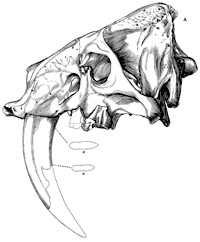Museum, University of Nebraska State

Bulletin of the University of Nebraska State Museum (1924–2023)
Date of this Version
2-1975
Document Type
Article
Citation
BULLETIN OF THE UNIVERSITY OF NEBRASKA STATE MUSEUM, VOLUME 10, NUMBER 1, PART 4 FEBRUARY, 1975, Pp. 47-54, Tables, Frontispiece, Figs. 1-3
Abstract
A ramus and partial premaxilla establish the presence of a new subspecies of Indarctos in the upper Pliocene (Kimball Formation, Ogallala Group) of Frontier County, Nebraska. An extremely large species of Agriotherium is represented by fragmentary remains from the middle Pliocene (middle part of Ash Hollow Formation, Ogallala Group) of Sherman County, Nebraska.
This study is part of a series of papers dealing primarily with the fauna of the Kimball formation in Nebraska (Barbour 1927, 1929; Barbour and Schultz, 1941; Schultz and Stout, 1948, 1961; Kent 1963, 1967; Tanner, 1967; Short, 1969; Martin and Tate, 1970; Schultz, Schultz, and Martin, 1970). The Kimballian fauna from Nebraska differs from the Hemphillian fauna in that most of the known forms are markedly more advanced, but definitely pre-Blancan (Early Pleistocene).
A large bear, Indarctos oregonensis keithi, new subspecies, from U.N.S.M. Coli. Loc. Ft-40 is included in the Kimballian fauna from Nebraska. An edentulous ramus and a radius of Agriotherium brought in by Frank Garvel of Ashton, Nebraska, from near U.N.S.M. Coll. Loc. Sm-101 in Sherman County, Nebraska, is also reported. This latter locality is Hemphillian in age (Ash Hollow Formation) and has produced Machairodus as well as some rhinoceros material (personal communication from Lloyd Tanner).
Included in
Entomology Commons, Geology Commons, Geomorphology Commons, Other Ecology and Evolutionary Biology Commons, Paleobiology Commons, Paleontology Commons, Sedimentology Commons


Comments
Copyright (c) 1975 University of Nebraska.